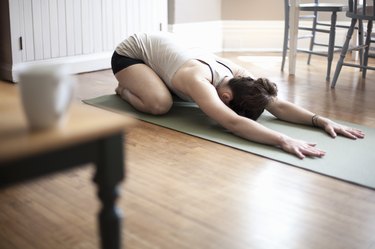
You may have heard of kegels, but do you know about reverse kegels? The reverse kegel relaxes the pelvic floor. When done correctly, the exercise has a few noteworthy benefits.
What Are Kegels?
Video of the Day
According to Mayo Clinic, kegels are exercises that work to strengthen the pelvic floor muscles, which support the bladder, uterus, small intestine and rectum. Reverse kegels, as the name suggests, do the very opposite: They relax the pelvic floor.
Video of the Day
The Pelvic Pain Foundation of Australia explains that the pelvic muscles can, in fact, be too tight. Tight muscles may ache and spasm, as well as lead to trouble with emptying the bladder, incontinence and even pain during sex. These symptoms can be alleviated by reverse kegel exercises.
Benefits of Doing Reverse Kegels
In women, reverse kegels can make sex less painful and help control bladder and incontinence issues. In men, reverse kegels can improve erectile dysfunction and help prevent premature ejaculation.
In a small study of 40 men with lifelong premature ejaculation, published in June 2014 in the journal Therapeutic Advances in Urology, it was found that pelvic floor rehabilitation exercises helped to treat premature ejaculation, a significant alternative to the more expensive treatment of selective serotonin reuptake inhibitors.
Read more: Advanced Kegel Exercises for Men
Reverse Kegel Exercises for Women
Reverse kegels can be done at home; no equipment needed. Examples of reverse kegel exercises for women include:
- Diaphragmatic breathing: The diaphragm works with the pelvic muscles to help create muscle relaxation and decrease pain. The National Association for Continence recommends placing one hand on your chest and another right below your rib cage. Breathe in deeply to the count of three and exhale to the count of four. Practice this breathing exercise for five to 10 minutes a day.
- Happy baby pose: Lying on you back, lift your legs — knees bent — and open your knees wider than your chest. Bring them toward your armpits, holding your legs behind the knees or at the ankles. Hold this position or gently rock back and forth, side to side.
- Child's pose: Begin with your hands and knees on a mat. Spread the knees apart, while keeping the big toes touching. Bow forward, shifting the torso downward and keeping the arms stretched out in front of you, fingers reaching away from your body.
- Adductor stretching: Simply lie on your back, soles of the feet together, knees out to the sides. You can put pillows underneath your knees for support.
Reverse Kegel Exercises for Men
The Pelvic Pain Foundation of Australia recommends reverse kegel exercises for men, including:
- Move the pelvic floor muscles: You can reduce pelvic pain by knowing how to relax and loosen your pelvic muscles. You can begin by slowly lifting your testicles up toward your body. This will tighten your pelvic muscles. You can then relax your pelvic floor and allow your testicles to hang loose. Practice this movement and focus on the relaxation stage.
- One-minute exercise: You can do this exercise while seated. Rest your feet on the floor, legs uncrossed, and allow your body to relax, slacken your jaw and let your belly and thigh muscles hang loose. Allow your pelvic muscles to soften, while breathing in five times and expanding your waist.
- Mayo Clinic: "A How-to Guide for Women"
- Pelvic Pain Foundation of Australia: "Pelvic Floor Muscle Relaxation for Men"
- Therapeutic Advances in Urology: "Pelvic Floor Muscle Rehabilitation for Patients With Lifelong Premature Ejaculation: A Novel Therapeutic Approach"
- National Association for Continence: "How to Relax Your Pelvic Floor"
Is this an emergency? If you are experiencing serious medical symptoms, please see the National Library of Medicine’s list of signs you need emergency medical attention or call 911.